Conventional Oil Market Research, 2031
The global conventional oil market was valued at $2.5 trillion in 2021, and is projected to reach $4.7 trillion by 2031, growing at a CAGR of 6.4% from 2022 to 2031. Conventional oil is an organic substance that is naturally formed within the earth's crust and is also referred to as crude oil or petroleum. It is a hydrocarbon, which means that its main ingredients are hydrogen and carbon with traces of other substances including nitrogen, sulfur, and different metals.
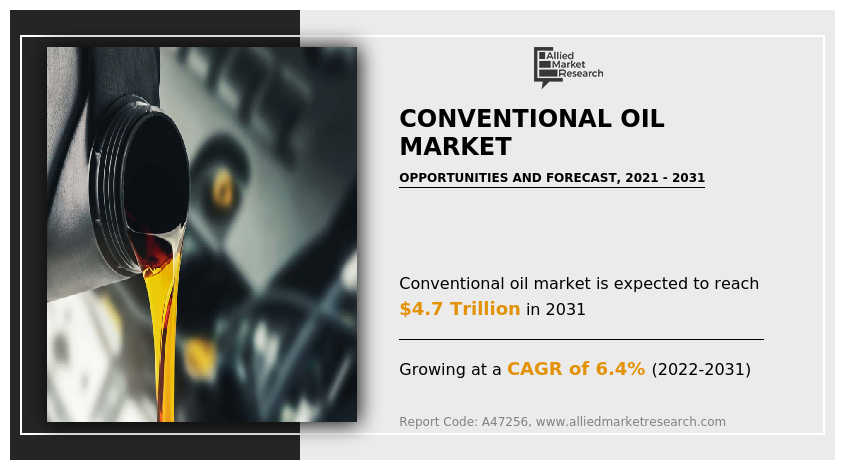
Conventional oil is extracted from the earth through drilling and pumping, which distinguishes it from oil sands oil. Conventional oil comes from geological formations that are very simple to extract and do not require specialized technology to harness their potential.
Conventional oil is frequently the most cost-effective option since they require significantly less refining and re-engineering. Several automakers still choose traditional engine oils as long as they meet the most recent industry standards. Furthermore, while conventional motor oils are closer to natural oil than synthetics or half synthetics, they still include essential additives to help reduce engine wear and increase performance. Advanced conventional oils have additives that can remove existing sludge from oilways and prevent fresh sludge from accumulating. All of these factors are expected to increase the conventional oil market share during the forecast period.
There are frequent changes in the price of conventional oil on a global scale. The uncertainty generated by oil price swings is expected to have an impact on economic development by increasing production costs or changing investment behavior, resulting in a slowdown of growth. All these factors are anticipated to hinder the conventional oil market growth during the forecast period.
Increase in auto production and demand for traditional and synthetic materials are expected to drive the market growth. Automobile sales have been gradually expanding in recent years, owing to population growth and an increase in consumer buying capacity in Asia-Pacific and Europe. The market is predicted to develop significantly during the forecast period due to the high level of technological advancement implemented in the entire automotive sector. There is an increase in demand for high-performance engine oils owing to tactical vehicle processes and operational blueprints used by multinational automobile manufacturers. All these factors are anticipated to create several growth opportunities for the conventional oil market players in the future.
The key players profiled in this report include BP, Chevron, Eni, ExxonMobil, Shell, Total, CNPC, Equinor, Petrobras, and Repsol.
The conventional oil market is segmented on the basis of type, sulfur content, end-use industry, and region. By type, the market is divided into light distillate, middle distillates, heavy ends, and others. By sulfur content, the market is classified into low sulfur and high sulfur. By end-user industry, the market is classified into automotive, chemical, power, industrial, and others. Region wise, the market is analyzed across North America, Europe, Asia-Pacific, and LAMEA.
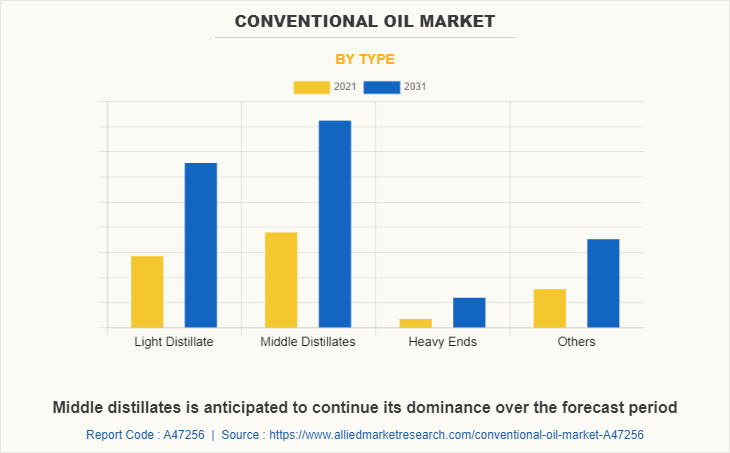
By type, the middle distillates sub-segment dominated the market in 2021. Middle distillates are a class of refined products that come from the fractional distillation of conventional oil into lighter and heavier products. Physically, they are clear, colorless to light yellow, flammable liquids with ten to twenty carbon atoms; their carbon chains are shorter than those of lighter distillates but longer than those of residual products. These are predicted to be the major factors affecting the conventional oil market size during the forecast period.
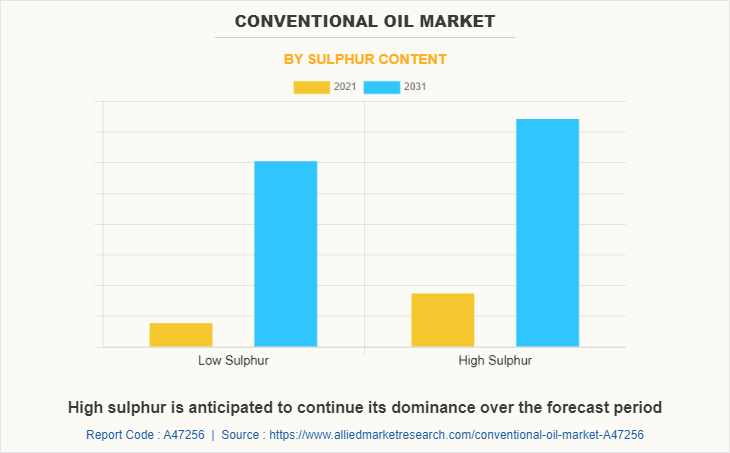
By sulfur content, the high sulfur sub-segment dominated the global conventional oil market share in 2021. Sulfur is a prevalent element present in crude oil and petroleum products. Sulfur is regarded as an undesirable pollutant because it produces sulfur oxides when burned. A crude oil grade with a high sulfur concentration will, on average, have a lower value. This high sulfur of conventional oil is sometimes referred to as sour crude. It can be utilized in all power plants, industries, industrial facilities, structures, and boilers. It offers significant savings because it is a type of fuel oil that burns at high temperatures.
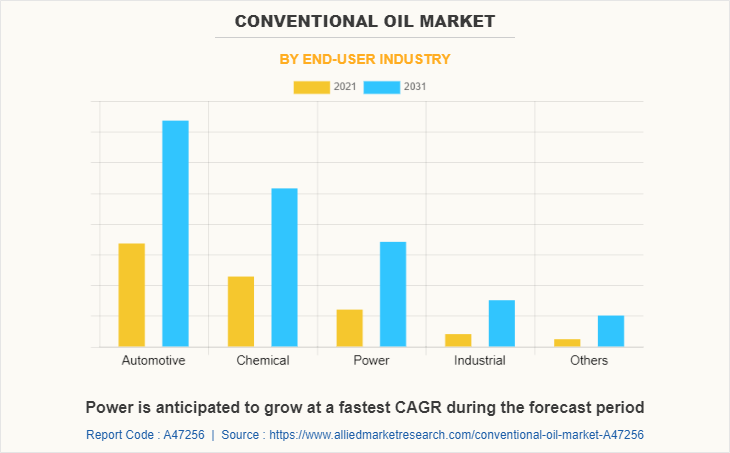
By end-user industry, the automotive sub-segment dominated the global conventional oil market share in 2021. Rise in disposable income and a quickly expanding urban population are responsible for the dominating share of the segment In regions such as North America and Europe, customer preferences in the passenger automobile segment have altered during the previous decade. This is also one of the major factors anticipated to boost the conventional oil market growth.
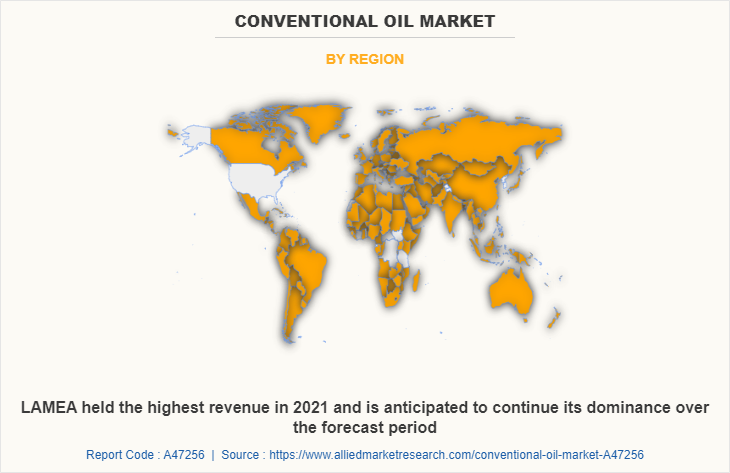
By region, LAMEA is projected to be the fastest-growing region during the forecast period. About 27% of the world's oil output comes from LAMEA, which is home to five of the top 10 oil-producing nations. In recent years, more than 30% of the world's refining capacity development has taken place in the Middle East, the second most dynamic upstream market, and even more of the world's substantial refining projects will be carried out there in the upcoming years. While state-owned corporations produce the majority of the oil, several multinational oil companies operate in the LAMEA through joint ventures, production-sharing agreements, and other business models. All these factors are anticipated to boost the conventional oil market growth in the region.
Impact of COVID-19 on the Global Conventional Oil Industry
- The global COVID-19 pandemic has not only posed a significant threat to human health, but it has also altered people's production and lifestyles. As the number of confirmed cases rises, countries have implemented measures such as lockdowns to limit the spread of the disease. As a result of these actions, the world experienced an economic blockade and the global supply lines were disrupted.
- COVID-19 had a negative influence on the conventional oil sector due to the severe lockdowns and social distancing rules implemented to contain the virus's spread
- Economic instability, a partial economic shutdown, and poor consumer confidence hampered the demand for conventional oil
Key Benefits For Stakeholders
- This report provides a quantitative analysis of the market segments, current trends, estimations, and dynamics of the conventional oil market analysis from 2021 to 2031 to identify the prevailing conventional oil market opportunities.
- The market research is offered along with information related to key drivers, restraints, and opportunities.
- Porter's five forces analysis highlights the potency of buyers and suppliers to enable stakeholders make profit-oriented business decisions and strengthen their supplier-buyer network.
- In-depth analysis of the conventional oil market segmentation assists to determine the prevailing conventional oil market forecast.
- Major countries in each region are mapped according to their revenue contribution to the global market.
- Market player positioning facilitates benchmarking and provides a clear understanding of the present position of the market players.
- The report includes the analysis of the regional as well as global conventional oil market trends, key players, market segments, application areas, and market growth strategies.
Conventional Oil Market Report Highlights
| Aspects | Details |
| Market Size By 2031 | USD 4.7 trillion |
| Growth Rate | CAGR of 6.4% |
| Forecast period | 2021 - 2031 |
| Report Pages | 290 |
| By Type |
|
| By Sulphur Content |
|
| By End-user Industry |
|
| By Region |
|
| Key Market Players | TotalEnergies SE, Exxon Mobil Corporation, Eni, BP p.l.c., Chevron Corporation, PETROBRAS, CNPC, EQUINOR ASA, Repsol, Shell Plc. |
Analyst Review
The global expansion of the automobile sector is one of the primary factors driving the growth of the conventional oil market. The use of conventional oil in electrical power generation, maritime, and aerospace applications has a favorable impact on the market. The rise in demand for conventional oil, which is less expensive than modern lubricants, has a further impact on the market. Synthetic lubes are popular because of their superior protection and longer-lasting performance. Also, the expansion of the automotive sector, surge in investments, and higher disposable income all have a beneficial impact on the conventional oil market. The high cost of producing conventional, as well as the availability of unconventional oil alternatives, are projected to hinder conventional oil market expansion. Economic growth is one of the most important factors influencing conventional oil product consumption and the rise in its demand. Energy consumption rises when economies grow, especially when it comes to transporting goods and resources from producers to consumers.
Among the analyzed regions, LAMEA is expected to account for the highest revenue in the market by the end of 2031, followed by Asia-Pacific, North America, and Europe. Increase in the usage of modern technology, which is resulting in the creation of advanced engine oil is the key factor responsible for the leading position of LAMEA and Asia-Pacific in the global conventional oil market.
The market is influenced by the rise in the need for conventional oil, which is more in demand because it is less expensive than modern lubricants. The popularity of synthetic lubricants can be attributed to their superior performance and long-lasting greater protection. These factors are expected to provide opportunities in the global conventional oil market.
The major growth strategies adopted by the conventional oil market players are investment and agreement.
The report provides an extensive qualitative and quantitative analysis of the current trends and future estimations of the global conventional oil market from 2022 to 2031 to determine the prevailing opportunities.
The automotive sub-segment of the end-user industry acquired the maximum share of the global conventional oil market in 2021.
LAMEA will provide more business opportunities for the global conventional oil market in the future.
BP, Chevron, Eni, ExxonMobil, Shell, Total, CNPC, Equinor, Petrobras, and Repsol are the major players in the conventional oil market.
Loading Table Of Content...



